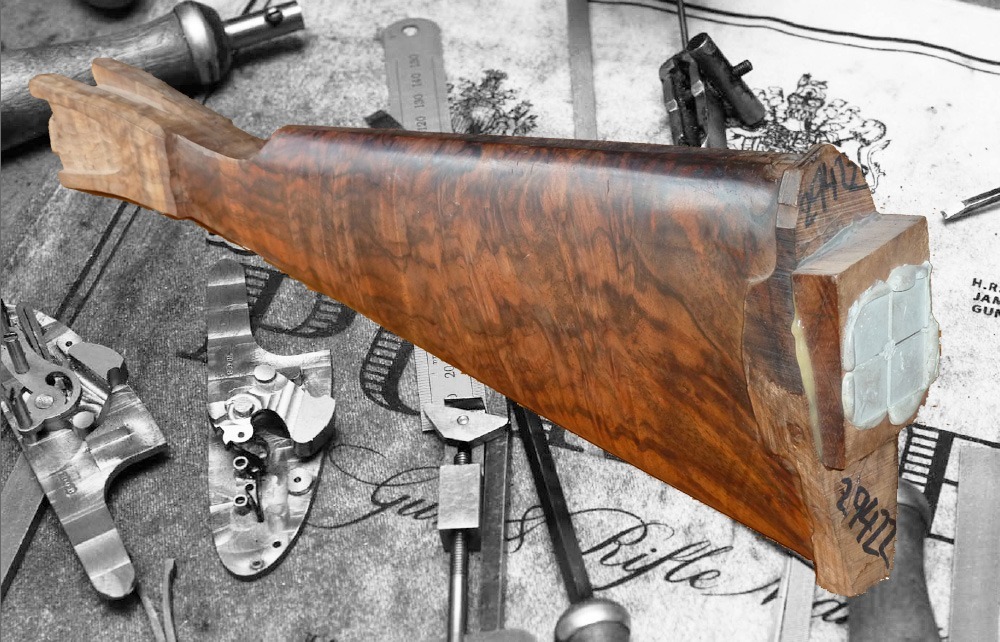Some years ago I had the privilege of visiting a leading maker of fine guns, James Purdey and Sons of London (Est. 1814), where I met their wood expert and buyer.
The common or English walnut (Juglans regia) is the wood of choice for gunmaking as it has superior strength and flexibility, and it holds tightly the surprisingly small screws that are used to mount the metal parts to the stock. The other quality in walnut is its beautiful figure of course. One gunmaker’s lyrical explanation of walnut figure captures it perfectly:
“mottles and motes, sunburst and fiddleback: as intricate as an opium dream.”
I was shown into Purdeys’ stockroom, an Aladdin’s cave containing thousands of beautiful wood ‘blanks‘; ready for the next customer to select their choice of wooden gunstock. The company go to enormous effort to source walnut of the right quality, with the emphasis on both beauty and strength. Today they source almost exclusively from the walnut forests of Turkey. Other sources have been used in the past but these have been either exhausted of suitable stock or proven to be too expensive due to access problems. Kyrgyzstan is a good example of the latter, where the mountainous terrain and poor infrastructure are significant barriers.
In the stockroom my eyes were drawn to one particular wooden blank that had been shaped and part-machined but lay amongst the thousands of other rectangular blanks on a shelf. It had beautiful figure and I wondered, aloud, why it has not been finished and used in a gun. The expert pointed out that though the figure was exquisite, the grain at the gun’s thinnest and most vulnerable point, the neck, ran across rather than along the blank. He explained that it had been shaped and machined to that point only because the customer was so keen of this particular piece of walnut. However, it could never be used as a blank as it would have been dangerously weak. He then surprised me saying “you can have it if you like?”

I was obviously delighted and have used it for years in talks and presentations. I polished one side of the blank to bring out the beautiful figure. Had this blank been perfect it would have been worth at least £10,000; if part of a matching pair over £25,000 for the two. This sort of value is rare in wood but of course Purdeys supply the highest end of the market where only the best will do.
Gabriel Hemery
 This work is licensed under a Creative Commons Attribution- NonCommercial- NoDerivs 3.0 United States License.
This work is licensed under a Creative Commons Attribution- NonCommercial- NoDerivs 3.0 United States License.

Hi Gabe,
Loved this piece on your blog, I also was lucky enough to be shown round Purdy and was fascinated by the stocks – some of which are incredibly satisfying to hold and look at – why? I’m not totally sure. I have a very old gun (was my great grandma’s) which has a lovely stock.
Am thinking again of making a small walnut plantation on the farm at home in Yorkshire – what’s the smallest size that is sensibly viable do you think and what is the best situation for walnuts (hillside, free drained, heavy/light soil etc) unfortunately most of our land is heavy with clay beneath! It possible that we could plant up a number of field corners and ground that is not really easy to farm.
Good to see you progressing so well and I hope life is really good for you and your family. Re your writing skills would you like to contribute from time to time to our two new publications TheBioenergySite.com and TheCropSite.com. These are just being got going now and an occasional column from you might be really good opportunity to share some alternative views/insight on land use with the world’s crop farmers.
Hi Malcolm
Great to hear from you and thanks for your comments. I will PM you to follow up.
Gabriel